
Portugal
Guimarães, nestled in the Minho region of northern Portugal, is renowned for its hearty, traditional Portuguese cuisine. This region's food often features rich flavors, substantial portions, and a strong emphasis on fresh, local ingredients. Minho's culinary identity combines robust meat dishes, from fertile inland farms, with fresh fish, from the Atlantic coast. The region is also the birthplace of Vinho Verde, an unique, light, and slightly effervescent wine that perfectly complements the local fare. Historically, the cuisine developed from the need for sustenance for farmers and laborers, leading to comforting, filling meals.
Minho cuisine distinguishes itself from other Portuguese regional cuisines. It differs from the lighter, seafood-focused dishes of the Algarve or the richer, often bread-based stews of Alentejo. Minho prioritizes hearty, satisfying meals.
Minho is known for its robust, comforting dishes, frequently featuring slow-cooked meats and a heavier reliance on ingredients like pork and cabbage. Its culinary identity is distinctly Northern Portuguese.
Breakfast is often light. Lunch is often the main meal, with "Prato do Dia" specials. Dinner later, more relaxed. Families and friends gather for more elaborate meals.
Deep-fried cod with thinly sliced fried potatoes, onions, and bell peppers. A comforting, flavorful cod preparation.
A Minho specialty, distinct from other cod preparations. Look for it in traditional restaurants and tascas.
Cubes of marinated pork, often fried, served with roasted potatoes, 'rojões' sausages, and 'grelos' (turnip greens).
A hearty, flavorful dish reflecting the region's agricultural focus. Many traditional restaurants offer this.
A rich, hearty stew with various pork meats, sausages, and pork blood, thickened with cornflour.
A robust winter dish, found in more traditional eateries. It has an unique flavor and texture.
Bifanas: Thin slices of marinated pork served in a crusty bread roll. A quick, savory, and tasty snack. Pastéis de Nata: Portugal's iconic custard tarts. Sweet, creamy pastries with a flaky crust. Found in bakeries.
Vinho Verde: The quintessential wine of the Minho region. Light, slightly effervescent. Port Wine: Readily available, a popular after-dinner drink. Medronho: A strong fruit brandy from the strawberry tree.
Some hotels and specialized restaurants offer upscale dining experiences. These focus on refined Portuguese cuisine, often with modern twists and presentation.
Numerous options exist in and around the historic center. These establishments offer traditional Portuguese cuisine in a comfortable ambiance, good for relaxed dinners.
Look for "tascas" or small "restaurantes" with a "Prato do Dia" sign. These are local, unpretentious establishments serving delicious, affordable, and hearty meals.
This traditional indoor market offers fresh produce, meats, fish, and local products. It is a place to experience local life, pick up ingredients if self-catering, or grab a simple snack.
More of a grocery market than a food hall, but worth visiting.
A growing number of pizzerias, Chinese, and Indian restaurants cater to broader tastes. These are mainly located outside the immediate historic center.
Find these in more modern parts of the city.
Rich almond cake, high egg yolk & sugar. No bacon.
Rich egg pudding with pork fat, sugar, Port wine.
Sweet, crispy fried dough often covered in sugar syrup.
Special pastries or dishes during festivals like Feiras Afonsinas, Christmas, Easter.
Very limited in Guimarães. It would be challenging to find dedicated Halal or Kosher establishments.
Travelers with these requirements would likely need to self-cater.
Rely on vegetarian/fish options verified to meet specific needs.
Always confirm ingredients directly.
Online forums and apps like HappyCow (for vegan/vegetarian dining) identify restaurants with suitable options in Guimarães.
During specific festivals, special pastries or dishes associated with the celebration may appear. For example, Feiras Afonsinas, a medieval fair, offers traditional medieval-inspired foods from temporary stalls.
Local tour operators or specific culinary schools may offer cooking classes focused on Minho cuisine.
The Minho region has many small farms and wineries. Organized tours to Vinho Verde vineyards near Guimarães or from Porto.
Check local listings for seasonal food festivals. These might include wine harvests or specific regional product fairs. Gastronomic events celebrate local produce.
Many restaurants within the old town are in beautifully restored medieval structures, adding to the dining atmosphere.
Experience dining in a truly unique setting.
Some establishments focus on a single dish, serving the best version of a local classic like Papas de Sarrabulho or Rojões.
For focused culinary experiences, ask for recommended specialties.
Experience dishes prepared with fresh, locally sourced ingredients reflecting the Minho region's bounty.
Sample regional cheeses, cured meats, and traditional sweets that capture the essence of local gastronomy.
Enjoy locally produced craft beers or traditional liqueurs alongside your meal.
Always confirm opening hours, especially for smaller, traditional establishments, as they may vary.